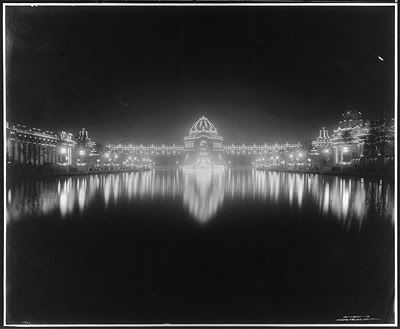Blue Highways: St. Louis, Missouri
Click on Thumbnail for MapUnfolding the Map
Heading east with William Least-Heat Moon, we cross the Missouri, then the Mississippi at St. Louis. We also have a cross-reference (I'll call it an intersection) with Jack Kerouac. If you want to see where we are, click on the map.
Book Quote
"Eighty miles out, rain started popping the windshield, and the road became blobby headlights and green interstate signs for this exit, that exit. LAST EXIT TO ELSEWHERE. I crossed the Missouri River not far upstream from where Lewis and Clark on another wet spring afternoon set out for Mr. Jefferson's 'terra incognita.' Then, to the southeast under a glowing skull-cap of fouled sky, lay St. Louis. I crossed the Mississippi as it carried its forty hourly tons of topsoil to the Louisiana delta."
Blue Highways: Part 1, Chapter 4
Littourati Intersection
On the Road: St. Louis, Missouri
St. Louis, Missouri
In my last post on St. Louis, I focused on the Gateway Arch, which wasn't built when Jack Kerouac went through, but was by the time Least-Heat Moon heads through town. But Least-Heat Moon's (I'm going to refer to him as LHM for short now) passage about St. Louis is very similar to Kerouac's. Both were heading in the same direction - east. Both remark on the air above St. Louis. For Kerouac, it was "great clouds of afternoon overtopping...". But LHM describes it more ominously, giving us more of modern, polluted big city feel when he writes of St. Louis with a "glowing skull-cap of a fouled sky." Both authors also point out the Mississippi River. Kerouac writes of logs carried down the current from Montana past steamboats, mud and rats, while LHM makes reference to the tremendous amounts of topsoil that washes into the Mississippi and is carried its length to fan out into the Gulf.
 Electricity Building at 1904 World's Fair in St. Louis
Electricity Building at 1904 World's Fair in St. Louis
One interesting aspect of St. Louis, besides the Arch, is the fact that it was once home of a huge World's Fair, the grounds of which are still open as a park, and its Catholic cathedral has some amazing mosaic work throughout its edifice. Kerouac didn't stop to take the sights in St. Louis, so focused was he on getting back to the East Coast, and I assume that LHM was probably familiar with all these aspects of St. Louis. But both of these attractions were for me extremely interesting. The Fair evidently popularized a lot of American food staples that we think of as essential American food today: ice cream cones, hamburgers, hot dogs, peanut butter, ice tea, and cotton candy, to name a few. A number of buildings from the Fair still exist on the Washington University of St. Louis campus. Many of the buildings were eye-poppers for their day. One building was devoted entirely to electricity, still a novelty in many areas, and was lit up with thousands of electric lights at night. The Fair was dedicated to the 100th anniversary of the Louisiana Purchase, the "terra incognita" that LHM cites above, and which Kerouac alludes to in On the Road when he mentions the logs floating down the river connected with our "continental dream." The Fair is also somewhat infamous for its "human zoos" in which aboriginal peoples from newly conquered American territories in the Philippines and Guam, as well as some Native Americans, were on display for the public to gawk at their "primitive" nature.
The Cathedral Basilica of St. Louis made a huge impression on me when I visited. The mosaics were started in 1912, not long after the cathedral was built, and not finished until 1988. The mosaics were designed by Albert Oerken and, on the sides, Tiffany Studios. They cover the entire cathedral and depict the life of King Louis the IX of France, the namesake of St. Louis, events in the archdiocese, and Old and New Testament stories. It is one of the largest collections of mosaics in the world. I like mosaics because the idea of taking bits of colored glass which by themselves are unremarkable and assembling them into something beautiful that tells a story is so symbolic. Our entire existences are really mosaics. Individual, unremarkable stars coalesce to form galaxies, which themselves, coalesce within the universe. Individual cells, each performing one function on its own, combines with other cells doing each doing their own duties to create a living being, and individual atoms combine in a mosaic to form those cells. Each individual person combines his or her actions and lives with others and forms a civilization. The words I write here, each individual in itself, combine to create this blog post in a mosaic of ideas. Finally, individual parts of us, including our strengths and flaws, combine in a mosaic to make us the people we are.
If you want to know more about St. Louis, the 1904 World's Fair, or the Cathedral Basilica
1904 World's Fair
1904 World's Fair Society
1904 World's Fair Virtual Tour
Cathedral Basilica of St. Louis
Explore St. Louis
Terry Laupp's 1904 World's Fair Page
Wikipedia: Cathedral Basilica of St. Louis
Wikipedia: Louisiana Purchase Exposition
Wikipedia: St. Louis
Next up: Lebanon, Illinois




 Friday, May 21, 2010 at 4:44PM
Friday, May 21, 2010 at 4:44PM